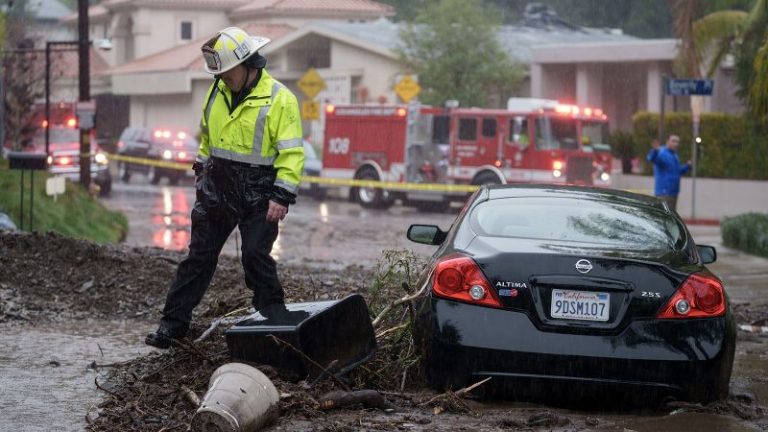Main points of the story
At least three killed in California
The flash flood threat extends to parts of Arizona, Nevada and Utah
Neighborhoods exposed to floods and mudslides
Los Angeles Mayor Karen Bass declared a state of emergency on Monday
CNN
—
a Strong storm system Parts of California were flooded, killing at least three people, knocking out power, and causing dangerous mudslides and rivers of debris that stretched through neighborhoods. The rain is slowly ending – and in some areas heavy snow – but some threats remain. Here's what happens:
• More rain and snow: Showers and occasional bouts of persistent rain will continue across Southern California on Tuesday. Additional rain is possible in valley areas, 1 to 3 inches in the foothills. Since Sunday, some areas in Los Angeles County have seen nearly a foot of rain. Rain also extended east Tuesday into western Arizona, southern Nevada and southwestern Utah, increasing the risk of flash flooding. A Level 2 of 4 risk of heavy rain is in effect Tuesday in these areas, according to the Weather Prediction Center.
• More than 300 mudslides in Los Angeles: Authorities in Los Angeles reported at least 307 mudslides during the storm. While the worst of the heavy rain is over, continued rainfall on Tuesday means more flooding and mudslides are still possible, and roads remain littered with trees and debris. Officials in Southern California urged anyone venturing outside to do so with extreme caution.
• At least three people were killed: At least three people died Sunday in California after trees fell on them during the powerful storm. Strong wind gusts of 40 to 60 mph were recorded where the three deaths occurred.
• Snow makes travel nearly impossible: The storm also dumped heavy snow, burying parts of the Sierra Nevada and Southern California mountain ranges. Snow and strong winds will continue to make travel conditions “nearly impossible” at high altitudes from southern parts of the Sierra Nevada to the central Nevada mountains through Tuesday evening, the weather service said. The service said heavy snow will spread inland this week, reaching higher elevations in Utah, Idaho, Wyoming, Colorado and New Mexico.
• Thousands are still without electricity About 140,000 customers were without power across California on Tuesday, according to poweroutage.us, especially in northern and coastal parts of the state, where violent winds knocked down trees and power lines over the weekend.
David McNew/AFP/Getty Images
This aerial view Monday shows a home destroyed by a landslide in Los Angeles.
More than 300 mudslides and more than two dozen buildings were damaged in Los Angeles
Across Southern California, neighborhood streets on Monday turned into swirling, muddy rivers that swallowed cars, swept away debris and stranded people and animals.
Scott Turow, a resident of Studio City in Los Angeles, told CNN that a violent mudslide in his neighborhood scattered neighbors' cars and left their street completely impassable, strewn with large rocks and tree branches. Toro told CNN that two of his neighbors' homes were damaged.
“Everyone seems to be fine, I mean we're all mentally shaken, but physically, we're all fine,” he told CNN. “We've been here 21 years,” he later added, “and we've never seen anything (like this) before.”
In Los Angeles, Mayor Karen Bass declared a state of emergency on Monday after the storm dumped nearly a foot of water in some areas, triggering mudslides and evacuations and rescues.
At least 307 mudslides and debris flows were reported in the city, according to a news release from Los Angeles Fire. Officials are also investigating whether 35 buildings damaged in the storm are safe. At least five of them have been red-flagged, meaning they are not allowing re-entry. Seven of them are classified as “yellow”, meaning passengers can enter to collect their belongings.
Crews are working to clear and repair damaged roads.
“As the storm continues, there are many flooded hills that have the potential to slide,” Los Angeles Fire Department Chief Christine Crowley said at a news conference on Monday. “We would like to reiterate to be extremely careful if you live or travel in these areas.”
Two evacuation orders remained in place Tuesday — one in the Owen Fire burn scar in Topanga Canyon and the other in the Agua Fire burn scar near Acton.
Lindsay Horvath, chairman of the Los Angeles County Board of Supervisors, said that although the damage officials saw was not as extensive as they had prepared for, the storm was “a thousand cuts.”
“Potholes, fallen trees, erosion areas,” she said. “But we're doing a good job and our crews are still out.”
Robin Beck/AFP/Getty Images
Water was pouring Monday along the Los Angeles River as the second and strongest of two weather river storms drenched the city.
December through March are the wettest months of the year for Southern California, but the extent of this week's deluge was highly unusual.
Record rainfall was recorded across Southern California on Sunday and Monday. Some of the most surprising totals appeared throughout the greater Los Angeles area.
Downtown Los Angeles experienced its third wettest two-day stretch on record Sunday through Monday, receiving 7.03 inches of rain, or 49% of its average annual rainfall. New daily rainfall records were set on both days when 4.10 inches and 2.93 inches fell, respectively.
Downtown Los Angeles has received 10.77 inches of rain since Jan. 1 — 75% of the city's annual precipitation in just five weeks.
A few areas of Los Angeles outside of downtown received more rain. The two-day rainfall total in the city's Bel Air neighborhood fell by one foot.
Los Angeles wasn't the only city to see record rainfall this week. Nearby Long Beach broke its daily rainfall record on Sunday and Monday, while Santa Barbara surpassed its daily record on Sunday.
CNN's Taylor Ward, Taylor Romine, Robert Shackelford and Stephanie Elam contributed to this report.

